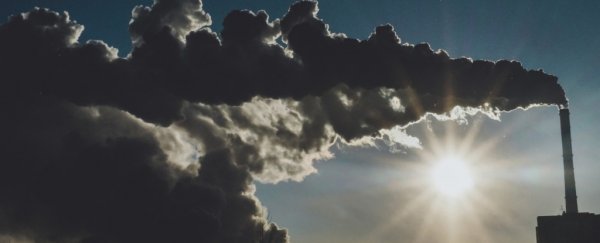Tiny bubbles of ancient air trapped in ice cores from Greenland suggest we've been seriously overestimating the natural cycle of methane, while vastly undervaluing our own terrible impact.
Methane is an 'invisible climate menace' - roughly 30 times more potent as a heat-trapper than carbon dioxide - and while some of this atmospheric gas is produced naturally, new research indicates humans are responsible for far more of it than we thought until now.
Before the industrial revolution, when humans began to extract and burn fossil fuels on the regular, natural methane emissions were an order of magnitude smaller than current estimates, the study suggests.
Today, this means our own methane emissions might be up to 40 percent higher than suspected.
"Our results imply that anthropogenic methane emissions now account for about 30 percent of the global methane source and for nearly half of [all] anthropogenic emissions… " the authors write.
Over the past three centuries, methane emissions have shot up by roughly 150 percent, but because this atmospheric gas is also produced naturally, it's been difficult to tell exactly where the emissions are coming from.
To figure out the scope of our own impact from coal, oil and natural gas, it's therefore necessary to know how much methane comes from wetlands and other natural sinks.
"As a scientific community we've been struggling to understand exactly how much methane we as humans are emitting into the atmosphere," says Vasilii Petrenko, a geochemist from the University of Rochester.
"We know that the fossil fuel component is one of our biggest component emissions, but it has been challenging to pin that down because in today's atmosphere, the natural and anthropogenic components of the fossil emissions look the same, isotopically."
There is one rare radioactive isotope however, known as carbon-14, which is contained in biological methane and not in fossil fuel methane.
By drilling and collecting ice cores in Greenland, Petrenko and his colleagues were able to use this isotope as a sort of time capsule for past atmospheres, ranging from roughly 1750 to 2013.
Until about 1870, the findings suggest very low levels of methane were emitted into the atmosphere and almost all of it was biological in nature. Only after this date was there a sharp increase in methane, coinciding with an increase in fossil fuel use.
In practice this means that each year, the scientific community has been underestimating methane emissions from humans by as little as 25 percent and as high as 40 percent. And while that might sound entirely grim, the authors see a silver lining on the edge of this dark cloud.
"I don't want to get too hopeless on this because my data does have a positive implication: most of the methane emissions are anthropogenic, so we have more control," says University of Rochester geochemist Benjamin Hmiel.
"If we can reduce our emissions, it's going to have more of an impact."
Compared to carbon dioxide, methane is short-lived in the atmosphere, so stricter regulations could have a sizeable impact on future greenhouse gas emissions.
And, at least in the United States, there's plenty of room for improvement in that respect. A study in 2018, for example, found methane emissions from oil and natural gas were 60 percent higher than those reported by the US Environmental Protection Agency.
This missing chunk could be part of the reason why we are currently underestimating methane emissions so much. It seems that what we are reporting on the ground is not matching up with what's going on in the sky.
The study was published in Nature.
